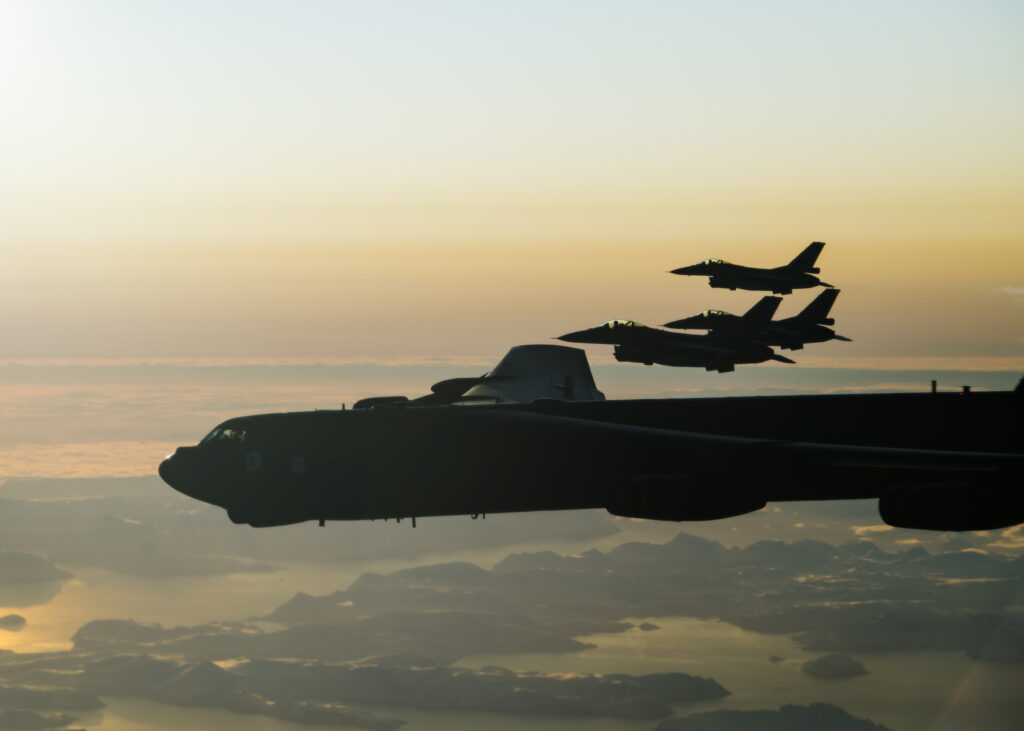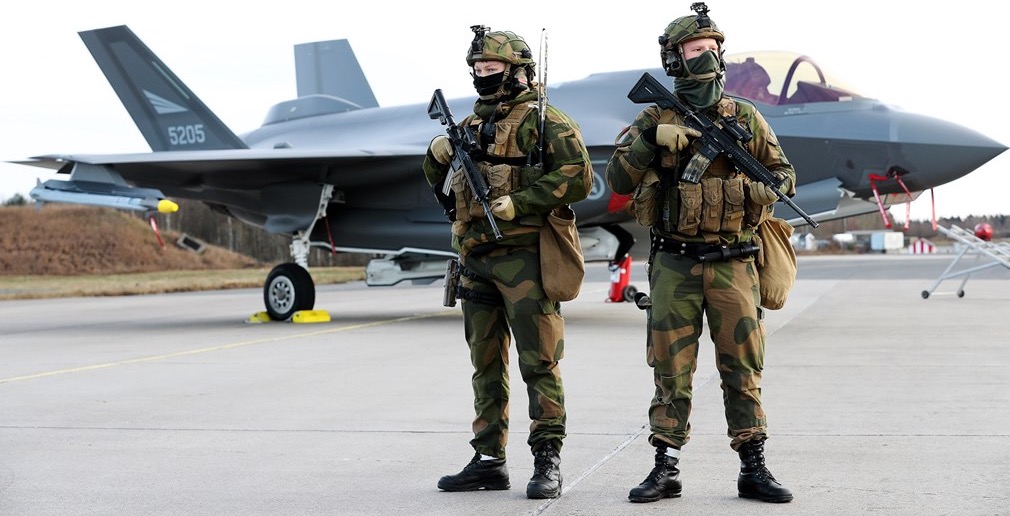
Three Royal Norwegian Air Force F-16s and a US Air Force B-52H fly over the Barents Sea above the Arctic Circle.
BODO MAIN AIR STATION, NORWAY: Three Norwegian F-16s from this remote base high above the Arctic Circle accompanied an American B-52 above the Barents Sea Wednesday for exercises that included information sharing with US P-8 surveillance planes operating nearby, a show of force that came a week after 10 Russian submarines cruised through the waterway in one of the biggest undersea exercises since the end of the Cold War.
F-16s from the 132nd Air Wing scramble daily from Bodo to patrol the Norwegian coastline near the heavily militarized Russian Kola Peninsula won’t have the mission for much longer however.
Plans call for the base to close at the end of 2021 followed by a transfer of the land to the city of Bodo, which plans to expand the commercial airstrip and build more housing. There’s still some debate in Oslo over whether to leave any capability to house military aircraft in extreme circumstances, but a final decision could be months away.
The mission of intercepting Russian fighter planes and bombers isn’t going away, but will shift from F-16s to new F-35As, with the Joint Strike Fighters moving about 190 miles north to the expanding Evenes air base, which will be home to Norway’s first F-35 squadron.
On Tuesday, the country took a major step toward that goal when Norwegian air chief Brig. Gen. Tonje Skinnarland declared Norway’s F-35As operational after completing a deployment at Orland Main Air Station. The move places Norway as the third European country to declare the plane operational, after the UK and Italy.
The planes are going to jump right into the fighting mix. In March 2020 Norway will deploy them to Iceland to run the NATO air-policing mission there, joining US P-8s which have been landing more frequently at Keflavik as the US modernizes the old Icelandic Cold War-era airfield to keep closer watch on Russian activities in the high north.

Rygge Air Force Base close to Oslo. Credit: Torbjørn Kjosvold, Armed Forces Norway
Norway will eventually operate 52 F-35As based out of Orland and Evenes. The F-35s will eventually join five of Norway’s own P-8s which Oslo ordered in 2017, giving the country a much-needed boost in its ability to hunt and track Russian subs at a time of increased Russian sorties into the North Atlantic. The planes would also be capable of assisting in search and rescue missions in the Arctic, as melting sea ice opens new shipping routes, and with them, greater potential for accidents.
The F-35s are sorely needed, Lt. Col. Gjorge Kleppe told a group visiting Bodo this week, as years of flying the air policing mission have “used up” the F-16s. If ou want some idea of how seriously Norway takes the Russian threat, the air wing remains on hair-trigger alert 24 hours a day. During one drill during my visit, it took two pilots just 12 minutes to get airborne after an alert call came in.
Norwegian officials here said the Russian submarine exercise is part of a broader Russian effort to push its modernized subs out to sea more often. It also validates Oslo’s P-8 buy, officials said, and underscores the need for more anti-submarine technologies on surface ships and helicopters. If Russian submarines and surface ships were ever able to close the critical stretch of water between Greenland, Iceland and the UK, known as the “GIUK Gap,” up to 80 percent of Norway would be cut off from resupply and reinforcement by sea, officials point out, making control of the waterway critical to Oslo’s security plans.
Air intercepts of Russian plans have increased in recent years, but appear to have leveled off somewhat, commanders said. Before 2007, “the intensity was very low” for the air policing mission with about 14 scrambles a year, Kleppe said. That shot up to 47 in 2007, and has leveled off in the mid-30s a year since then. One F-16 pilot at the base said the last intercept was several weeks ago.
Those intercepts will no doubt continue, but Russian pilots will soon be met more quickly from the new base farther north, and will have to contend with new, stealthy F-35s.
Connecticut lawmakers to grill Army, Lockheed about job cuts at Sikorsky helicopter unit
“The Connecticut delegation has questions about why, with that [FY24] appropriation in hand, this happened,” said Rep. Joe Courtney, D-Conn.


























